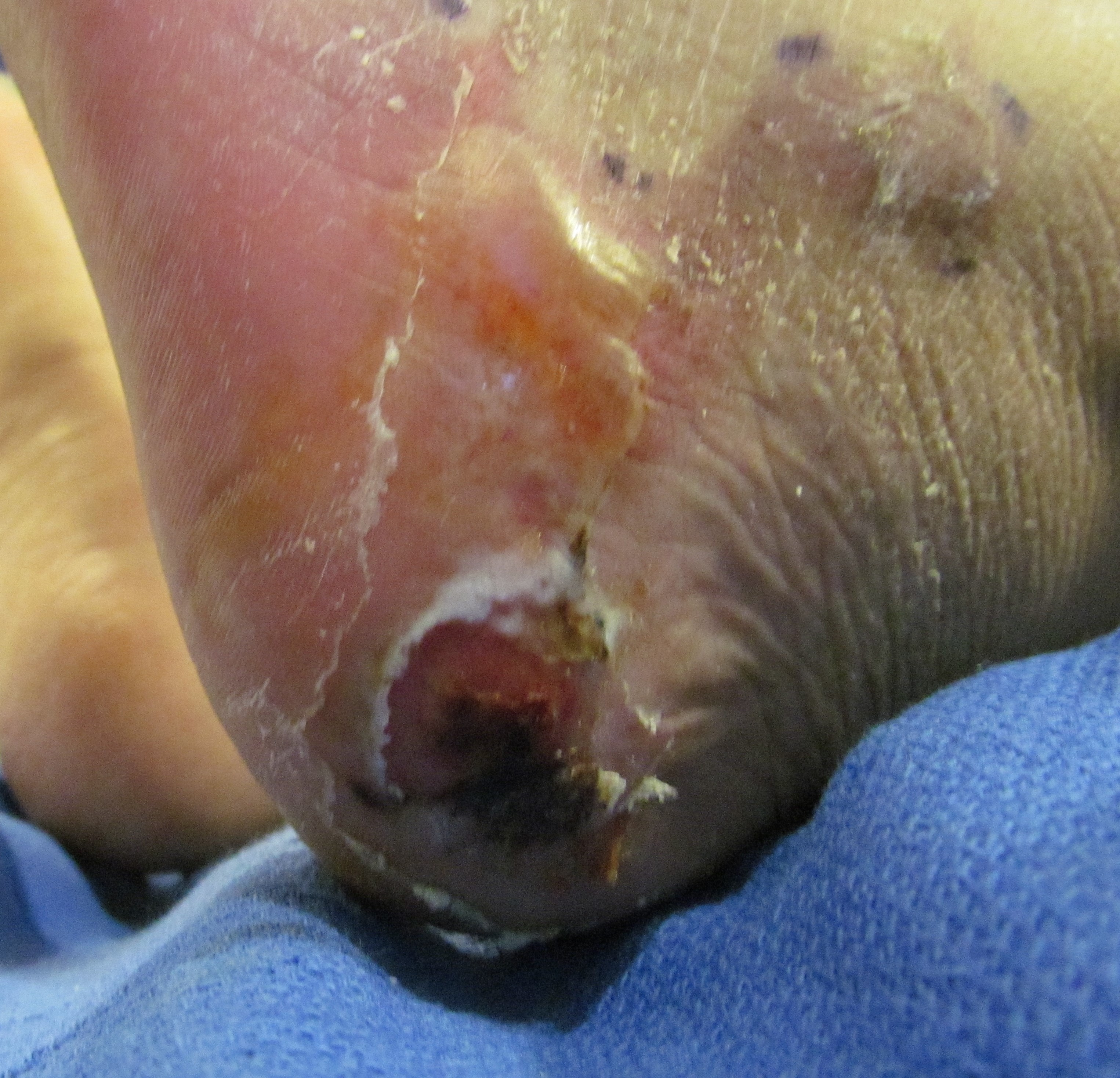Pressure Injuries with Eschar

The wound in the attached photo would be staged, using NPUAP guidelines, as which of the following:
A) Stage III
B) Stage IV
C) Unstageable
D) Suspected deep tissue injury
Answer: C
Wounds caused by shear and/or pressure that are covered with eschar such that the depth of tissue injury is not visible are termed “Unstageable.” The definition in the NPUAP guidelines is as follows: obscured full-thickness skin and tissue loss. Full-thickness skin and tissue loss in which the extent of tissue damage within the ulcer cannot be confirmed because it is obscured by slough or eschar. If slough or eschar is removed, a Stage III or Stage IV pressure injury will be revealed. Stable eschar (Ie, dry, adherent intact without erythema or fluctuance) on the heel or ischemic limb should not be softened or removed. [1]
This definition provides not only direction on how to document a wound covered with eschar or slough, but also on how to initiate a treatment plan. Treatment of most unstageable wounds, such as the one in the first photo, begins with removal of the necrotic tissue, after which the wound can be restaged according to the depth and tissue involved. However, when the wound is on the heel of a non-ambulatory patient or on an ischemic extremity, and the edges are adhered with no signs of infection, debridement is contra-indicated. See below:

The saying is that such an eschar is God’s band-aid, intact and keeping external contaminants out of the underlying tissue. In the case of inadequate blood supply for healing, removal of the necrotic tissue will only lead to a larger, non-healing wound. This reinforces the standard of care which dictates that evaluation of any wound below the knee must include a vascular exam.
Snyder et al. proposed this checklist for wound management in order to promote a standard of care among all clinicians who see patients with wounds, and is especially helpful in evaluating pressure injury, what is the cause, and why the wound is not healing. The checklist is as follows:
- Did you obtain a complete medical history, including wound history?
- Did you assess the wound by measuring length by width by depth as well as evaluating wound tissue?
- Did you determine the etiology of the wound and address comorbidities?
- Did you assess for pedal pulses and swelling?
- Did you assess for localized or systemic signs of infection?
- Did you plan to remove unhealthy tissue from the wound?
- Did you assess for sensation in the foot with a monofilament or other method?
- Did you assess if the patient requires offloading or compression?
- Did you assess pain?
- Did you educate the patient on wound etiology, treatment, and prevention?
- Did you consider referral to a specialist?2
In the context of pressure injuries, one could add these questions:
- Did you determine the cause of the mechanical force creating the tissue injury?
- Did you educate the patient, family, and/or care-giver on strategies to remove the source of mechanical force?
- Did you initiate removal of necrotic tissue when appropriate?
- Did you address nutritional status with the patient?
Removal of necrotic tissue can be accomplished by sharp, autolytic, enzymatic, or biological (maggot) techniques, depending on the location, amount of necrotic tissue, pain levels, and time constraints during the first visit. There are many different aspects of treating patients with pressure injuries, and one of the most important is to always remember that one is treating a patient with a wound, not a wound on a patient.
[1] National Pressure Ulcer Advisory Panel, European Pressure Ulcer Advisory Panel and Pan Pacific Pressure Injury Alliance. Prevention and Treatment of Pressure Ulcers: Clinical Practice Guideline. Emily Haesler (Ed.). Cambridge Media: Osborne Park, Western Australia; 2014. Available at www.internationalguideline.com/static/pdfs/NPUAP-EPUAP-PPPIA-CPG-2017.pdf.
2Snyder RJ, Jensen J, Applewhite AJ, Couch K, Joseph WS, Lantis JC, Serena TE. A standardized approach to evaluating lower extremity chronic wounds using a checklist. Wounds. 2019;31(5 Suppl):S29-S44.
Additional information on evaluating and treating patients with pressure injuries can be found at the following:
Garcia AD, Sprigle S. Pressure injuries and ulcers. In Hamm R (Ed), Text and Atlas of Wound Diagnosis and Treatment: 2nd edition. New York: McGraw Hill Education. 2019, 171-198. Available at https://accessphysiotherapy.mhmedical.com/book.aspx?bookid=1334.
[1] National Pressure Ulcer Advisory Panel, European Pressure Ulcer Advisory Panel and Pan Pacific Pressure Injury Alliance. Prevention and Treatment of Pressure Ulcers: Clinical Practice Guideline. Emily Haesler (Ed.). Cambridge Media: Osborne Park, Western Australia; 2014. Available at www.internationalguideline.com/static/pdfs/NPUAP-EPUAP-PPPIA-CPG-2017.pdf.
Create a Free MyAccess Profile
AccessMedicine Network is the place to keep up on new releases for the Access products, get short form didactic content, read up on practice impacting highlights, and watch video featuring authors of your favorite books in medicine. Create a MyAccess profile and follow our contributors to stay informed via email updates.